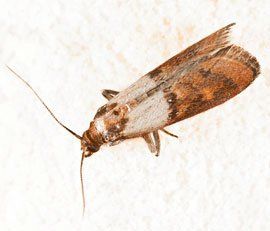Moth Pest Control
Local Moth Extermination
Moth Treatment Process
Immediate Moth Removal
Moth Treatment Options
Habitat reduction methods: This strategy is designed to eliminate areas that moths breed or remove the resources they need to survive. This includes discarding infested materials, properly sealing stored grains, removing clutter, and vacuuming regularly.
Insect growth regulators: There are dusts and other products available that interrupt a moth’s ability to develop into an adult.
Chemical pesticides: These are chemical pesticide sprays that can be applied locally to heavily infested areas. These residual chemicals will kill any moths that come in contact with the spray.
Signs of Moths
The most common signs of an active moth problem really depend on the species of moth.
- The most noticeable signs will be holes in clothes and fabric. Holes in fabric are made by caterpillars feeding which means that moths have already started to breed.
- A silk like webbing on the surface of stored grains is another sign of meal moths. The silk webbing on stored grains means that moths have found a stable source of food and have established a nest.
- Moth eggs are another sign of moths, but they are hard to see and usually in obscure places where they are not likely to noticed.
Damages Caused by Moths
Moth infestations result in high numbers of moth larvae. These caterpillars are responsible for most of the fabric damage attributed to these moths. They feed on just about any organic materials including silk, hair, fur, and feathers. In large numbers these caterpillars can devastate clothing that have been left alone for long periods of time. They can also cause significant damage to furniture upholstery when houses stay vacant during off seasons.
Tips to Get Rid of Moths
The best way to get rid of moths is to be vigilant for signs of moth activity and to treat impacted areas. It also helps to remove any infested materials and any potential food sources they have been feeding on. Once infested materials have been removed, be sure to vacuum thoroughly and wash all fabrics, clothing, linens, and bedding on high heat. Apply chemical pesticides to all surfaces that contain any fabrics and use dusts in hard-to-reach areas.
Where to Find Moths
Moths prefer to stay in hidden dark areas that are least likely to be disturbed by human activity. This is why moths select the following places to hide and breed:
- Underneath beds: Below beds provide a dark, undisturbed cavern that rarely gets cleaned which is why it is perfect for moths to breed.
- Infrequently used cupboards and drawers: This is where grains and other stored goods are often stored. If these goods go undisturbed for a long period of time, they will provide the perfect place for moths to nest.
- Attics, garages, and basements: Both locations remain dark and undisturbed and often have clothes or linens in storage.
- Closets: The back of closets usually contain coats and other fabric rich outer wear. These places are kept dark and cool which provides moths the perfect place to infest.
How to Prevent Moths
Preventing moths can be difficult because there is little that can be done to deter them. The only real option would be to implement exclusion strategies to ensure that moths can’t find access into your home. The best way to do this is to close and seal any access points like vents, windows, doors, cracks, and gaps. They are also attracted to lights so keeping lights active in the evenings will attract them to open doors and windows. Keep lights off to minimize moth activity close to your home to keep moth populations out.
Contact Griffin Pest Management
If you have noticed moths or signs of moth damage in your home, call Griffin Pest Management today to schedule an inspection. One of our licensed and experienced moth control experts will help identify problematic areas and create a customized plan designed to effectively exterminate moth populations. Our strategy will utilize an integrated pest management approach that combines the benefits of several treatment strategies. This includes vacuuming / sanitation, storing goods, spraying pesticides, and applying a growth regulating dust.
Moth Pest Control FAQs
-
How did I get moths?
Clothes moths often get brought in when infested materials are introduced into a home. The moths or their eggs can come in with used good purchased from thrift stores, garage sales, and other secondhand stores. Pantry moths can get brought in from the store in other stored goods before infesting your kitchen pantry.
-
How serious are moths?
On a scale of harmful or damaging insects, moths fall short of bees and termites. However, like many insects, with enough food and resources, moth populations can grow to numbers that can cause a good amount of damage. With enough time, they can destroy large amounts of fabric including those used in furniture upholstery.
-
What are signs of a moth infestation?
The most common signs of moths include the moths themselves, holes in clothing, crust on rugs, curtains, or clothing, and silky threads found on fabrics. These all indicate that you have moths in different stages of their life cycle.
Moth Pest Control Testimonials
100% Satisfaction Guaranteed
Cities We Service
Don't see your location? Most surrounding areas covered. Call for more information.
Los Angeles County
Orange County
Locations
Santa Ana1415 East McFadden Ave. Suite D Santa Ana CA 92705
San Diego934 S Andreasen Dr. Unit DEscondido CA 92029
All Rights Reserved | Griffin Pest Management


